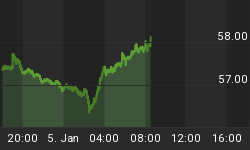We spend a lot of time discussing the relationship between gold and the US$, not just because the trend for the US$ is by far the most important influence on the gold price but also because this relationship is so widely misunderstood. Most financial market analysts understand that a weaker dollar is bullish for the gold price while a stronger dollar is bearish, but fail to appreciate that the relationship only operates at a trend level. In other words, knowing what the US$ did on any particularly day, week, or even month, will often not tell you much about what the gold price did during the same day, week or month. This is because there are leads and lags between the markets and these leads/lags are not consistent. Also, gold and the dollar regularly make moves that are out of proportion to each other. For example, a 5% fall in the dollar could just as easily be associated with a 1% rise in the gold price as with a 30% rise. However, what we do know is this: If the primary trend for the US$ is down then the primary trend for the gold price will be up. Similarly, if the primary trend for the dollar is up then the primary trend for the gold price will be down.
In our 9th April commentary we showed a chart comparison of the gold price and the Swiss Franc (SF) to highlight the similarity of the trends in these two markets (gold and the US$ trend in opposite directions so gold and the SF trend in the same direction). We'll now take a look at the leads/lags that have occurred in the gold-SF relationship over the past few years.
On the below chart comparison of gold futures and SF futures, the significant peaks and troughs for the gold price and the corresponding peaks and troughs for the SF over the past 2 years have been labeled 'a' through 'f'. A vertical blue line has been drawn through each of the SF's significant peaks and troughs. Note that apart from peak 'b', which occurred concurrently for the SF and the gold price, every peak/trough in the SF over the past 2 years has followed an equivalent peak/trough in the gold market by 1-3 months. That is, the gold market has consistently led the currency market over the past 2 years.

Does the above chart represent something out of the ordinary? To find out whether it does or not we compared the performances of the gold price and the SF during the first half of the 1970s. The first half of the 1970s is the most logical period to use in this exercise because, as we've shown in the past, gold stocks over the past few years have followed a similar path to the one followed by gold stocks during 1972-1974.
The below chart compares the gold price and the SF from the beginning of 1971 through to the end of 1975. Once again the significant peaks/troughs on the gold chart and the corresponding peaks/troughs on the SF chart have been given identical labels. Note that every significant peak/trough in the SF shown on the below chart followed an equivalent peak/trough in the gold market by 1-4 months. That is, the gold market consistently led the currency market during the first half of the 1970s. Also note that although a high positive correlation between gold and the SF is obvious in the below chart, the moves in the two markets were generally not in proportion to each other. For example, peak 'c' in gold was followed, about 2 months later, by peak 'c' in the SF, but whereas gold's peak 'c' was about 40% above its prior peak (peak 'a'), peak 'c' for the SF was below its prior peak.

Further to the above, when we take a wide-angle view of market action the relationship between gold and the US$, or gold and the SF, is straightforward and consistent. However, when we zoom-in to shorter time periods the relationship becomes more complicated with leads/lags and out-of-proportion moves being more the rule than the exception. It is certainly interesting, though, that similarities between the gold market action of the early 1970s and the gold market action of the past few years continue to be evident.
By the way, the lead/lag relationship between gold and the SF that existed during the first half of the 1970s did not occur during the second half of the 1970s. In fact, as the bull market in gold and the bear market in the dollar moved towards their respective conclusions the gold and currency markets became less correlated. This is no doubt due to the increase in speculative activity and the reduced focus on the underlying fundamentals that often occur as a trend becomes widely recognised.















